The problem of abstract art, which has been discussed in these pages with the hypothesis of the role of Ticino, is mainly related to the question of its beginnings and that of its definition, which, remaining partly contradictory, makes it, paraphrasing a concept of Umberto Eco, close to an “open” work. That is why in order to better define its contours, one should first decide what is meant by abstract art. We would still find ourselves, even then, treading on slippery ground, because among scholars there is no correspondence of intent: for many, abstract art is an art that has severed its connection with the past. For others, that thread of connection has instead kept it alive. It is obvious that with such antithetical positions, it runs the obligation to take a step back at least with a question: is art only a form of expression? And if so, does it exclude those experiences that do not take place through words, concrete forms and objects, which also make up an essential part of the history of vision? Let us make the point with abstract art because, from that moment, a debate is ignited that pits figurativism against realism, abstraction and even “engagée” art. Doubts about the origins of abstract art have also been formulated since the idea that this exceptional artistic temperament, would be born with what Argan called “doodle,” namely, Vasily Kandinsky’s (Moscow, 1866 - Neuilly-sur-Seine, 1944) First Abstract Watercolor of 1910, began to crumble. This is an emblematic case, in that it was the painter’s second wife, Nina Andreevskaya (Moscow?, 1899 - Gstaad, 1980) who set that date while, in fact, the work was made in 1913. Numerous other hypotheses followed for the same date, which was moved forward or backward in time. “It was certainly backdated,” argued Denys Riout, “in no way corresponding to what the artist was painting at that time, ” 1 while other theorists have shifted it to 1911, that is, to when Kandinsky was making the Improvisations series, and in the same years he was working on Spiritual in Art. From the time "[Kandinsky] began to title his works Impressions, Improvisations, Compositions, he adopted musical definitions in his works in relation to the important novelty of twelve-tone music introduced by Schoenberg in Vienna, thus assimilating the lesson of an abstract art, which is nevertheless capable of translating and inspiring emotions. From that point on, many scholars saw in it a variation in his creative procedure and, above all, a change in the direction of all modern art: the abstract art revolution was breaking out.
 |
| Vasily Kandinsky, First Abstract Watercolor (1910; Watercolor, pencil and India ink on paper, 49.6 x 61.8 cm; Paris, Centre Pompidou) |
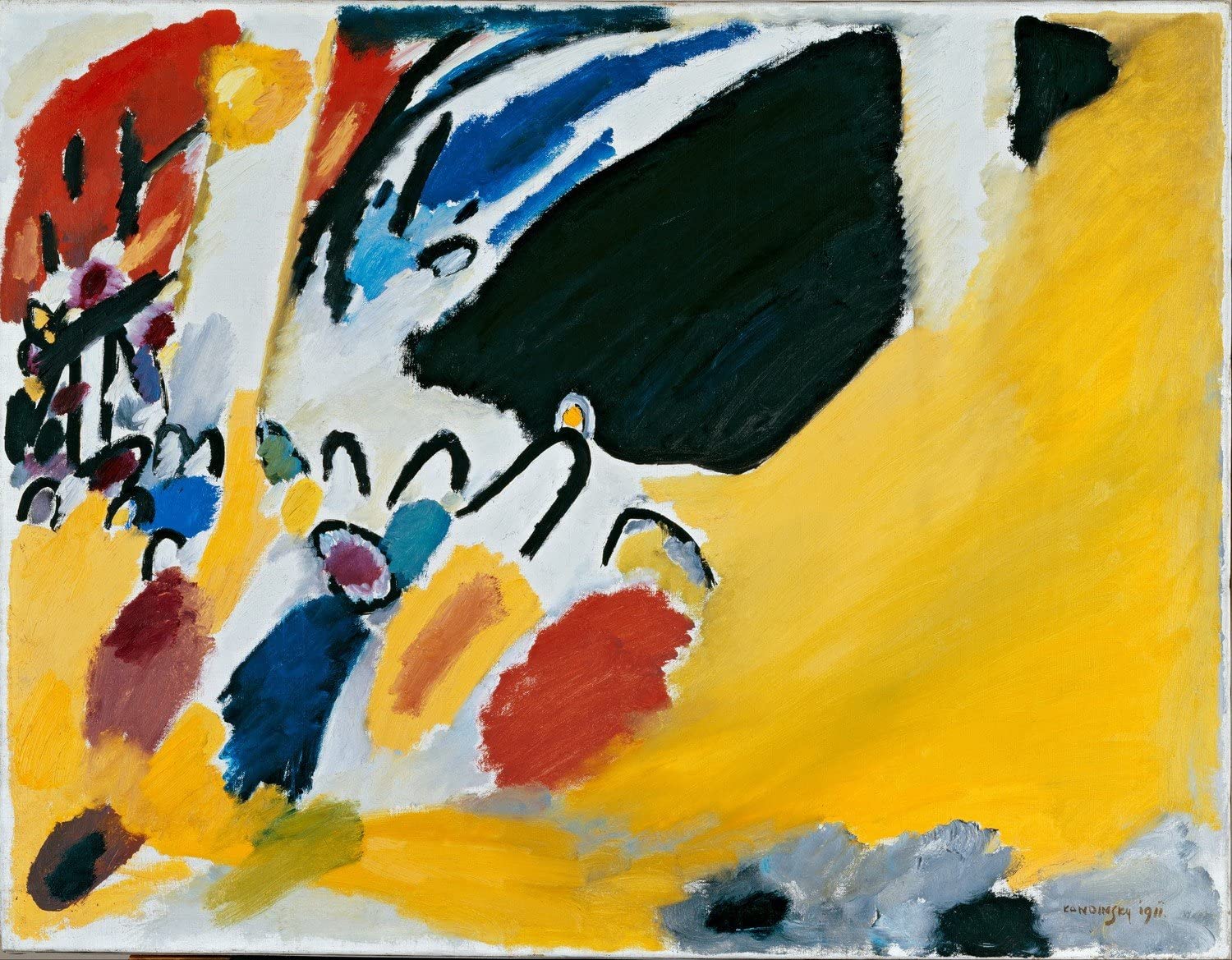 |
| Vasily Kandinsky, Impression III (Concert) (1911; oil on canvas, 77.5 x 100 cm; Munich, Städtische Galerie im Lenbachhaus) |
 |
| Vasily Kandinsky, Improvisation 19 (1911; oil on canvas, 120 x 141.5 cm; Munich, Städtische Galerie im Lenbachhaus) |
But did it really happen that way? The origins argument is not the only one under discussion today. Is it not more correct, as many now believe, to return to a set of factors, and not to a single artist and city, the instances and conditions that allowed the emergence of this art in the twentieth century? After all, there had been, yes, Kandinsky, then Mondrian and Malevič, but before these, artists such as Kupka, Delaunay, and a few women such as Hilma af Klint, Marguerite Haghenbach, second wife of Jean Arp, who enabled the spread of abstract art in Ticino, had also appeared on the path of abstraction. If not even Giorgiana Houghton (Las Palmas, 1814 - London, 1884). So there were many and varied, more than is known, circumstances that led to this artistic upheaval, and there were also many personalities who began to feel the need for art that tended toward abstraction. Some little-known publications in Italy and recent exhibitions have made it possible to reconsider not only the dating but also the places of origin of abstract art. Indeed, there was not only Munich, as the first major propelling center (and the city where Kandinsky worked in certain years), the birth of abstract art: “ it simultaneously affected multiple centers in Europe: Paris, (Munich), London, Moscow, Prague, Rome and, later, the United States, ” 2 and, in our opinion, Switzerland as well, with incursions, at least, as anticipated, by such personalities as Marguerite Haghenbach (Basel, 1902 - Locarno, 1994), perhaps also by Mikalojus Konstantinas Čiurlionis (Var?na, 1875 - Pustelnik, 1911) and Hilma af Klint (Solna, 1862 - Danderyd, 1944) and the Italian active in Switzerland Alberto Sartoris (Turin, 1901 - Pompaples, 1998). And a little further on, Luigi Pericle (Luigi Pericle Giovannetti; Basel, 1916 - Ascona, 2001) was also to play a decisive role not so much in the birth as in the diffusion of that artistic dimension that expressed itself in a manner that was no longer figurative. It has been repeatedly emphasized how far from reality it is often to argue that an artistic novelty occurs without intermediate steps, and all of a sudden: instead, every cultural novelty needs fertile ground and a more or less long gestation process to mature. Again Denys Riout, speaking of Kandinsky, confirmed this in his essay. Speaking of “abstraction by decantation,” he emphasized how the descent of abstract art had occurred by means of a “progressive transition,” which, by the way, allows one to stop understanding an artistic novelty as a necessary break with the immediately preceding art or tradition 3. To recompose this thread of events and to set a more realistic date for the appearance of abstraction on the scene of history, it is therefore necessary to intercept in the watermark the warnings that made it possible to speak of abstract art as an avant-garde.
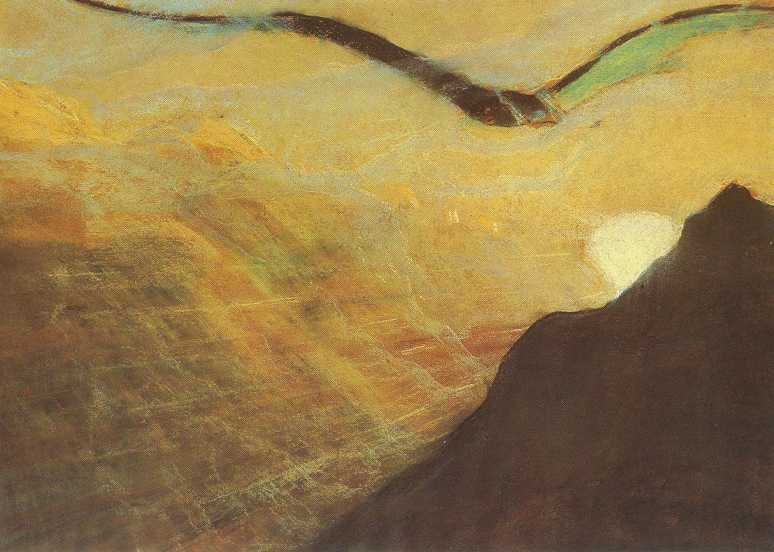 |
| Mikalojus Konstantinas Čiurlionis, Žinia (1904; pastel on paper, 64.2 x 90.7 cm; Kaunas, National Čiurlionis Museum) |
 |
| Mikalojus Konstantinas Čiurlionis, Sonata VI. Allegro (1908; tempera on paper; Kaunas, National Museum Čiurlionis) |
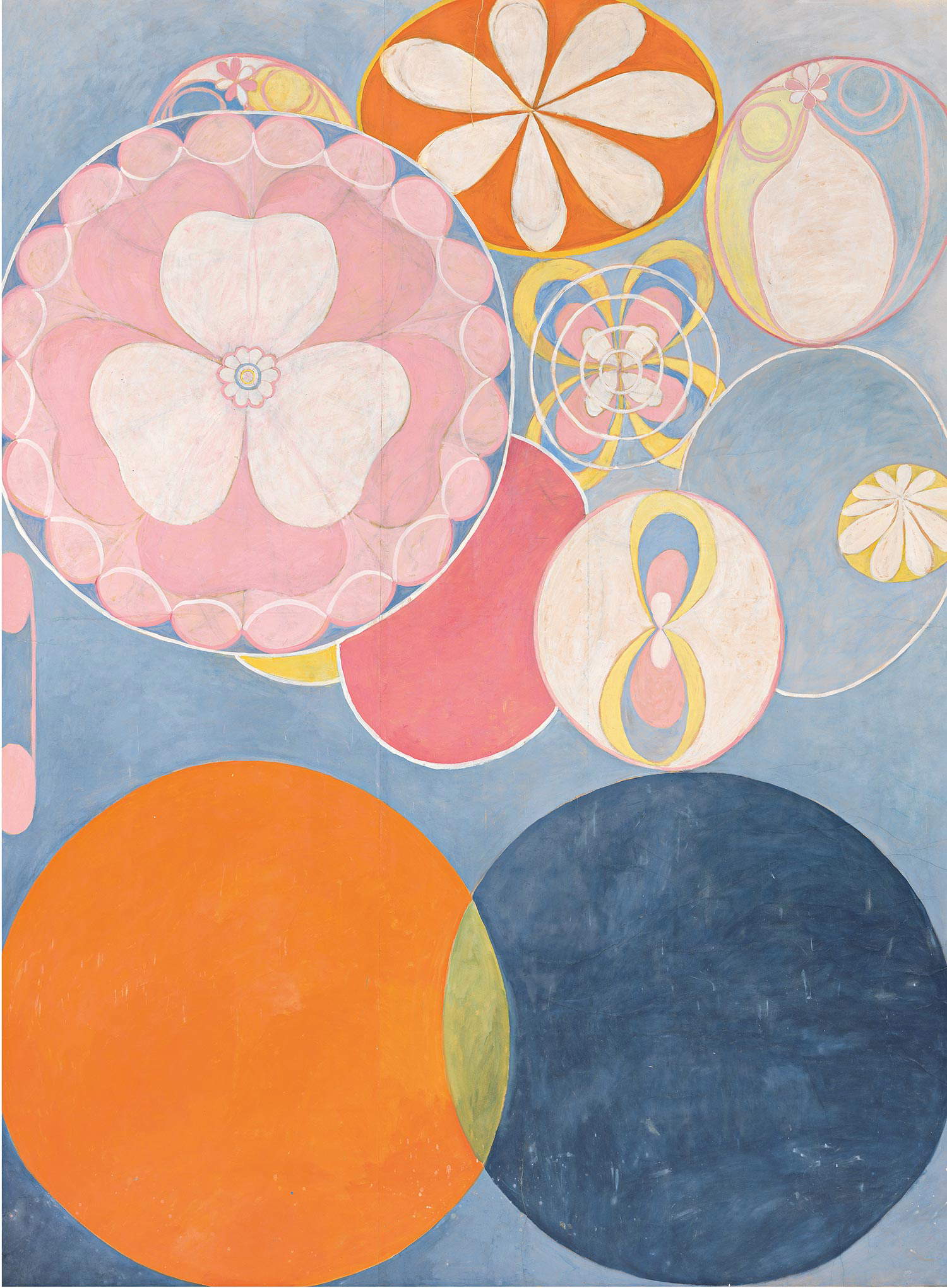 |
| Hilma af Klint, De tio största nr 2, Barnaåldern (1907; oil and tempera on canvas, 328 x 240 cm; Stockholm, Stiftelsen Hilma af Klints Verk). Ph. Albin Dahlström/Moderna Museet |
 |
| Hilma af Klint, Erosserien, nr 8 (1907; oil on canvas; Stockholm, Stiftelsen Hilma af Klints Verk). Ph. Albin Dahlström/Moderna Museet |
 |
| Hilma af Klint, Grupp X nr. 1, Altarbild (1915; oil on canvas, 237.5 x 179.5 cm; Stockholm, Stiftelsen Hilma af Klints Verk). Ph. Albin Dahlström/Moderna Museet |
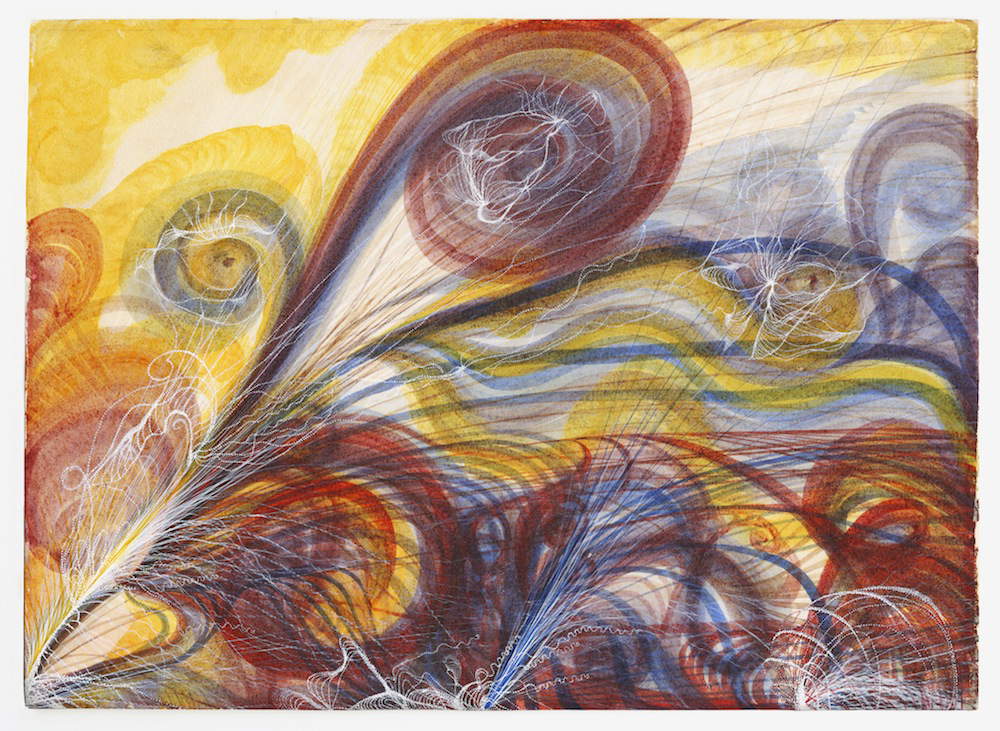 |
| Georgiana Houghton, The Eye of God (c. 1862; watercolor on paper, 54 x 44 cm; Melbourne, Victorian Spiritualists’ Union) |
So what were the anticipations that allowed abstraction to deflagrate in multiple cities? Let us take up the case of Nina Kandinsky, when in 1953, in the bimonthly of the Venice Biennale 4, she intervened to oppose many positions held by the critic Aleksis Rannit, who in an earlier publication corresponded the birth of abstraction to the artist’s visit to the Impressionists ’ exhibition at the end of the 19th century and also to the relations between him and Čiurlionis, a native of Lithuania. Of the latter, Mrs. Kandinsky made mention only to refute the assumption that her husband had visited Lithuania. Actually, in her letters, among the other “precursors” of abstract art, besides Čiurlionis, she made no mention of Hilma af Klint, an artist who has been reevaluated too recently 5 and who lived in too much isolation from her contemporaries to be considered by Mrs. Kandinsky in her review of the 1950s. In short, if one does not want at all costs to “dethrone” Kandinsky from his role as a pioneer of abstract art, however, more clarity and investigation is needed on several levels and even on the role of women. In the early years of the twentieth century, as is well known, Western civilization is experiencing a moment of great cultural, political, geographical, and economic upheaval. Studies also begin to take an interest in subjects not considered before, such as theosophy, with the publications for example, of Rudolf Steiner(Theosophie, 1904) and that of Annie Besant and Charles W. Leadbeater(Thought-Forms, 1905), the studies on the mind and the unconscious of Sigmund Freud and Carl G. Jung. These are also the years of the advent of the philosophies of Eckhart, Schopenhauer and Nietzsche, Eastern and Western mystical traditions, and so on. Such instances respond to a “widespread need for spirituality” (S. Poggi), an aspect inherent in that need for artistic experimentation devoted to the tension of transcending the visible and going beyond material, objectual contingency. In the era called “of the Great Spiritual,” abstract art (understood as non-figurative language), was most appropriate, and it was therefore crucial that the forms of the material object be replaced by abstract forms. But did this really have to mean “painting psychic states” 6 and dematerializing concrete forms? And since when more precisely did scholars and artists begin to put themselves in this frame of mind? It will be many who abandon figuration, not just Kandinsky, nor will he be the first or last to do so. “A few years later in fact, in 1914 [circa 1914, nda] but through a completely different route, Mondrian, in Paris [and Malevič in Moscow, nda]” 7 as well as many others before and elsewhere. Some works by František Kupka, Robert Delaunay, even Munch are to be counted as illustrious precedents. In particular, in the economy of our discourse that also wants to shed light on the role of Hilma af Klint, the works of Edvard Munch, those, in particular that included shadows in the painting(Puberty for example), are a point to be emphasized, because these paintings, according to Sixten Ringbom, would soon find reverberation in Kandinsky’s production, such as in the 1912 painting Lady in Moscow, because there were already “represented” abstract forms swirling around the figure of the woman. But if this work was a “parallel representation of a material reality with the occasional influence of a spiritual atmosphere, ” 8 how should we define Hilma af Klint’s pictorial production, starting, for example, with Tystnad (“Silence”), from 1907, since that painting already presented a synthetic stylization of organic forms and plants? And how should it be thought of? A “representation of human relationships” or a declination of decorative art? The affinity of abstract art with decorative art also still needs to be well clarified. Who was Hilma af Klint and why is she still not mentioned enough in the perspective of abstraction? Is she not mentioned enough because she was a woman?
 |
| Edvard Munch, Puberty (1894-1895; oil on canvas, 151.5 x 110 cm; Oslo, Nasjonalgalleriet) |
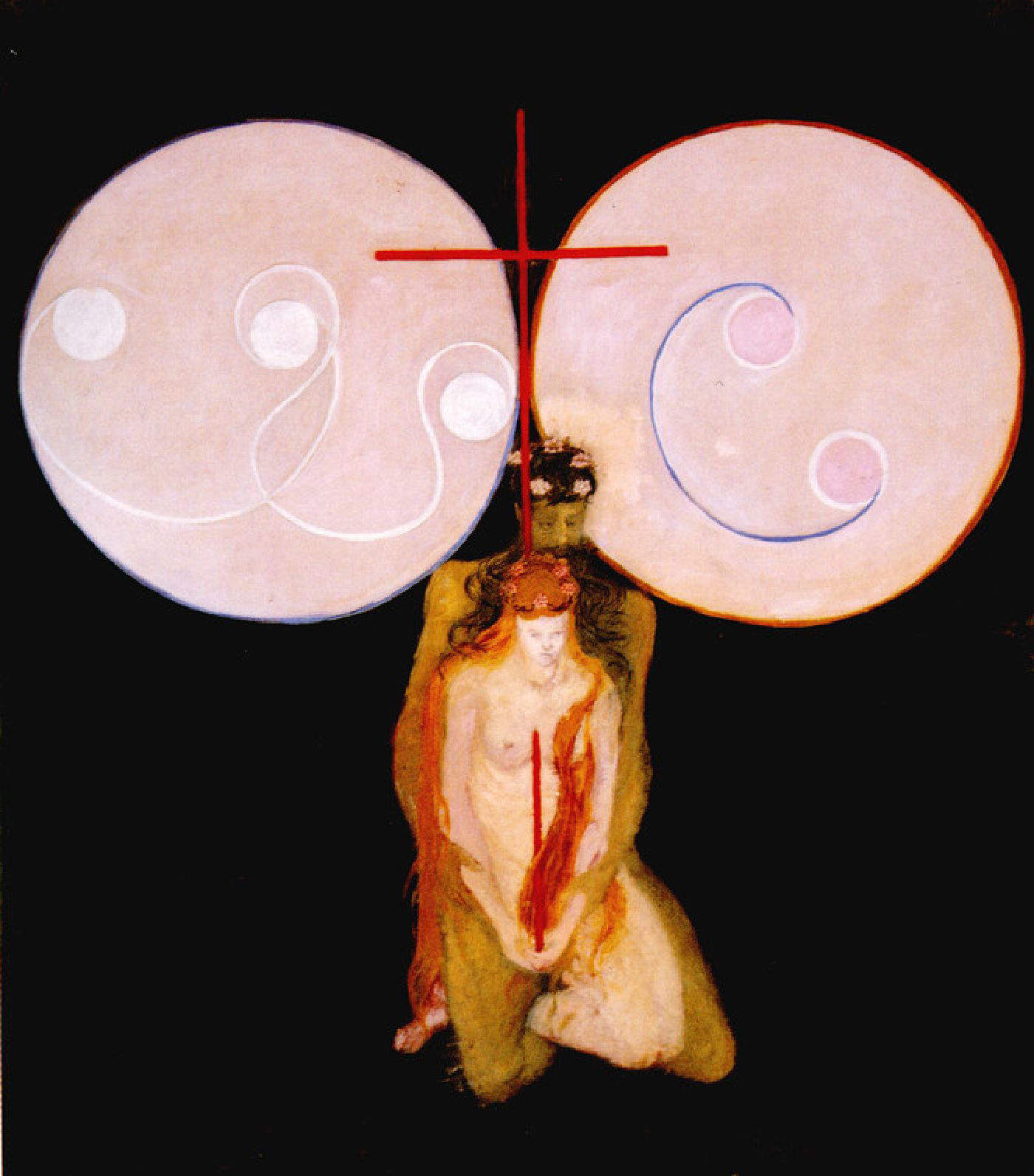 |
| Hilma af Klint, Tystnad (1907; oil on canvas, 164 x 148 cm; Stockholm, Stiftelsen Hilma af Klints Verk) |
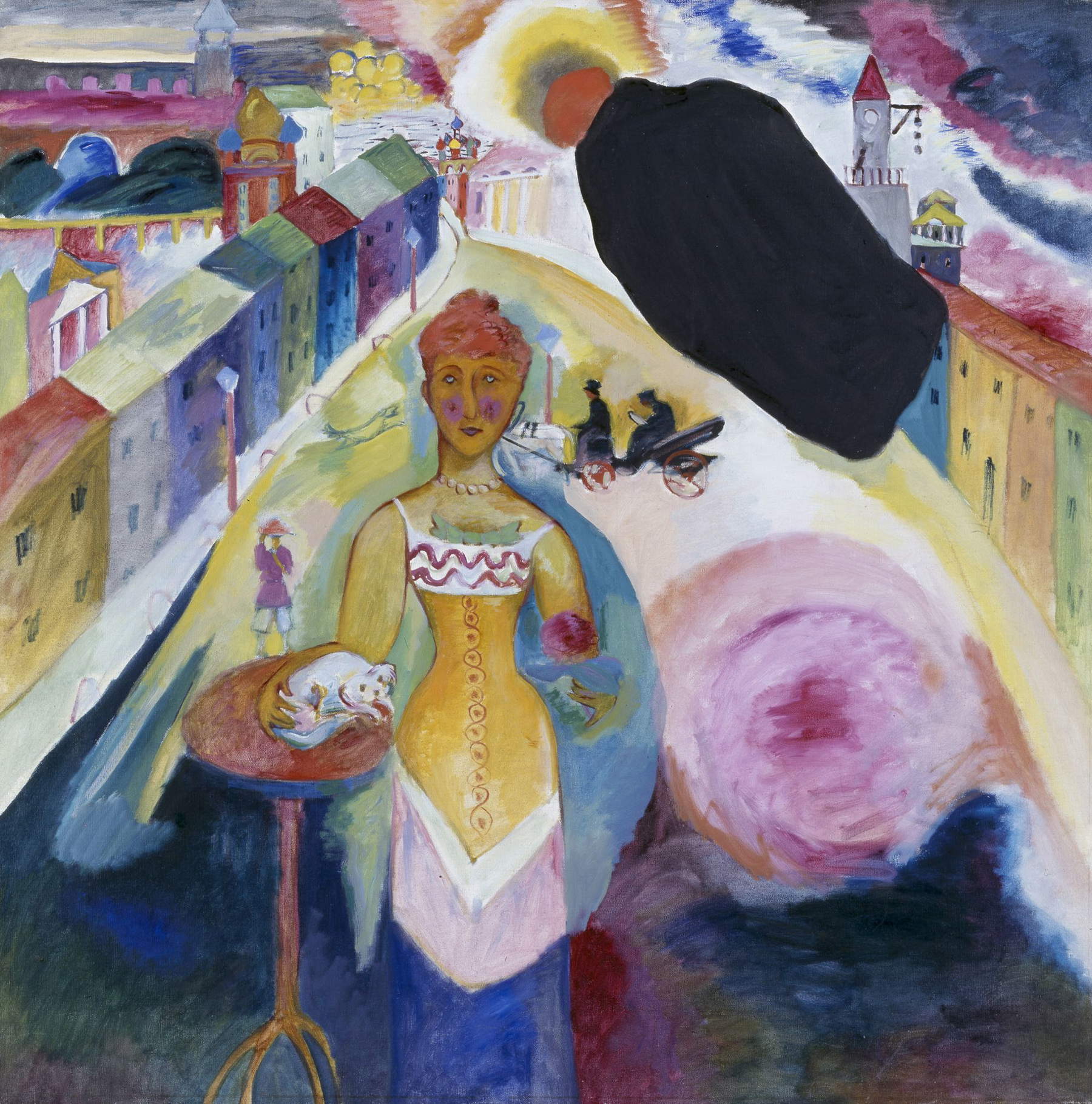 |
| Vasilij Kandinsky, Lady in Moscow (1912; oil on canvas, 108.8 x 108.8 cm; Munich, Städtische Galerie im Lenbachhaus) |
Originally from Stockholm, the city where she attended the Kungliga Konsthögskolan (Royal Academy of Fine Arts) 9, Hilma af Klint visited Blanch’s Art Salon, where, in 1894 a famous exhibition dedicated to Edvard Munch was held. In 1906, thus before Kandinsky, in unremarkable times, Af Klint “began to invent a new way of painting, a visual language that had no connection with the way of painting and looking at art in the terms she had learned (in the Academy) her syncretic paintings drew from many different sources, including those provided by the spiritual movement of Theosophy” 10 (another point to be explored further).
And who was Marguerite Haghenbach? And what role did she, along with Marianne Werefkin, play in the spread of abstract art? Always women. And how did their artistic positions contrast or parallel with their respective husbands, Jean Arp and Alexej von Jawlensky? Research must continue, if as we have already documented, Ticino, where these personalities gravitated, was a center of lively cultural ferment in those years. It seems well established, however, that even before 1910-13, and not only in Munich an unprecedented and innovative scenario began to emerge, in which fundamental was a language that expressed a need for the spiritualization of artistic work. This, for some scholars was explicable “in a society whose modes of behavior [were] conditioned by industrial labor, ” 11 and the common need responded to the ability of artists to distance themselves from it. Now this need was also felt by other personalities not just artists. It is no coincidence, then, that the reality of Monte Verità was developing precisely in these years, and it was not secondary to consider that later in the 1950s Harald Szeeman found fertile ground for his ideas in Ticino, as Luigi Pericle would later do, arriving from Basel in 1954.
Notes
1 Abstract art, in D. Riout, The Art of the Twentieth Century. Protagonists, themes, currents, Piccola Biblioteca Einaudi, 2000, p.23.
2 M. Mazzotta, “Music and the Spiritual in Art. A Path” in Kandinsky - Cage. Music and Spiritual in Art, ... p.13.
3 On the subject Salvatore Settis has recently published for Feltrinelli, “Incursions. Contemporary Art and Tradition.”
4 Issue 12, 1953. Here he also mentions the profound emotion Kandinsky felt when confronted with Claude Monet’s Haystacks, an occasion that led him to question the question, which we quote in full and in the original language: “Le peintre pourrait-il aller plus loin encore et créer des compositions sans figuration aucune comparables aux symphonies des compositeurs?”
5 Beginning with the Pioneer of Abs raction exhibitions held at the Moderna Museet in Stockholm and the exhibition, curated by Tracey Bashkoff held at the Guggenheim Museum in New York in 2018, where they also put the spotlight on the importance of Theosophy vis-à-vis abstraction.
6 S. Ringbom, Replacing the missing object in, Transcending the visible: the generation of the abstract pioneers,......1986, p. 131
7 D. Vallier, Abstract art, the cosmos of the pure image. Origins and developments of a new perception from Kandisnky to minimal art," Garzanti, 1980, p.7.
8 Ibid, p. 143.
9 J. Voss, A mediated magic. The Indian presence in modernism 1880 - 1930, Naman P. Anuja & Louise Belfrage, 2019, p. 131.
10 Ibid, p.133.
11 C. G. Argan, Modern Art. 1770-1970, Sansoni editore, 2002, p.219.
Warning: the translation into English of the original Italian article was created using automatic tools. We undertake to review all articles, but we do not guarantee the total absence of inaccuracies in the translation due to the program. You can find the original by clicking on the ITA button. If you find any mistake,please contact us.